- The mass loss history from its progenitor, a pulsating red-giant star moving along the Asymphtotic Giant Branch (AGB) towards very high luminosities (103–104 Lsun). This includes the time variation of the mass loss rate, which is believed to be modulated by repeated helium-shell flashes (thermal pulses) occurring in the stellar interior; the geometry of the mass loss; and the hydrodynamical evolution of this slowly expanding wind (V=10km/s, M=10–4–10–5 Msun/yr);
- The energetic radiation from the stellar remnant after the envelope ejection. Photons not only ionise the envelope, but also have notable dynamical effects: moving ionisation/recombination fronts create temperature and pressure discontinuities which result in shock waves forcing redistribution and acceleration of the outflowing gas;
- A hypersonic wind (V=several 103km/s, M=10–9 Msun/yr) blown from the stellar remnant during its high luminosity and high temperature post-AGB phase. This fast wind quickly reaches the regions occupied by the former, slower and denser AGB wind and drives into it a strong shock wave;
- The interaction with the surrounding interstellar medium.
- Corradi, R. L. M., Perinotto, M., Villaver, E., Mampaso, A., Goncalves, D. R., 1999, ApJ, 523, 721. Citation in text | ADS
- Corradi, R. L. M., Schonberner, D., Steffen, M. & Perinotto, M., 2000a, A&A, 354, 1071. Citation in text | ADS
- Corradi, R. L. M., Villaver, E., Mampaso, A., Goncalves, D. R., Perinotto, M., Schwarz, H. E. & Zanin, C., 2000b, ApJ, 535, 823. Citation in text | ADS
- Corradi, R. L. M., Livio, M., Balick, B., Munari, U. & Schwarz, H. E., 2001, ApJ, in press. Citation in text
- Doyle, S., Balick, B., Corradi, R. L. M. & Schwarz, H. E., 2000, AJ, 119, 1339. Citation in text | ADS
- Goncalves, D. R., Corradi, R. L. M., Mampaso, A., 2001, ApJ, in press. Citation in text
- Marten, H., Schonberner, D., 1991, A&A, 248, 590. Citation in text | ADS
- Mellema, G., 1995, MNRAS, 277, 173. First citation in text | Second citation in text | ADS
- Schwarz, H. E., Aspin, C., Lutz, J. H., 1989, ApJ, 344, L29. Citation in text | ADS
- Schwarz, H. E., Aspin, C., Corradi, R. L. M. & Reipurth, B., 1997, A&A, 319, 267. Citation in text | ADS
- Soker, N. & Rappaport, S., 2000, ApJ, 538, 241. Citation in text | ADS
| THE ING NEWSLETTER | No. 4, March 2001 |
|
|
THE ING WIDE FIELD IMAGING SURVEY | SCIENCE |
|
|
|
| Previous: | Scientific Impact of Large Telescopes | Up: | Table of Contents | Next: | NAOMI – Adaptive Optics at the WHT |
Other available formats: PDF | gzipped Postscript
Normal and Eccentric Dying Suns
Romano L. M. Corradi (ING)*
*: Romano is a Research Fellow at ING.
In recent years, a lot of effort has been put into better understanding the physical processes which lead a sunlike star, at the end of its evolution, to lose its gaseous envelope and die as a slowly cooling white dwarf. The most spectacular phase of this late evolution is the one in which the ejected envelope is made fluorescent by the energetic radiation from the naked stellar core, in which the last thermonuclear reactions take place. These ionised nebulae, historically (and misleadingly) called 'planetary nebulae', are among the most beautiful objects in the Universe, and are the key to understanding phenomena which are relevant to many fields of astrophysics and particle physics.
One of the modern problems covered
by the study of planetary nebulae (hereafter PNe) is the dynamical evolution
of the gas ejected by the star, and the consequent formation of the amazingly
wide variety of large- and small-scale morphological structures which are
observed. We know that the dynamical evolution of a PN is governed by the
following processes:
All these processes must be
taken into account when trying to reproduce the observations of real PNe.
In addition, they must be treated in a time-dependent way, since the properties
of winds and radiation from the central star vary on short timescales owing
to its very rapid post-AGB evolution. In spite of these difficulties, nowadays
sophisticated radiative/hydrodynamical models that take into account all
the processes above are available in 1-D, 2-D, or even 3-D (e.g. Marten
& Schonberner, 1991, Mellema,
1995). A detailed comparison with the observations is therefore
possible, and it is along this line that a good fraction of my recent research
has been directed. The study has taken advantage of many observational
facilities worldwide: for imaging, the 2.5-m NOT at ORM, the 3.5-m NTT
at ESO, and the HST. For the kinematical studies, the NTT, the NOT and
the 4.2-m William Herschel Telescope with its echelle spectrograph UES.
Some results are schematically illustrated in the next sections.
'Normality': Spherical Shells for Stellar Paleontology
It is nowadays known that the
classical model of PNe as spherical expanding shells applies to only 10–20%
of all known Galactic PNe. NGC 2438 is one of those. We have obtained deep
narrow-band images and echelle spectra of this rather old PN, revealing
the existence of two giant haloes surrounding the main body of the nebula
(Corradi
et al., 2000a, see Figure 1). Hydrodynamical
modelling of these data shows that NGC 2438 is an excellent case to illustrate
the effects of most of the physical processes mentioned before.
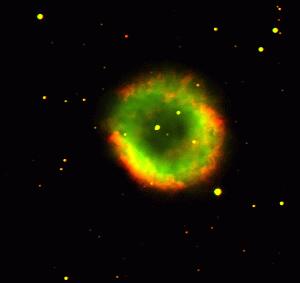 |
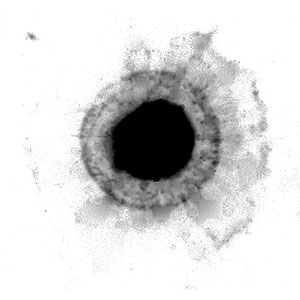 |
| Figure 1. Left: Color-composite image of the inner nebula of NGC 2438. Green is the [OIII] emission at 5007Å, red is the hydrogen H-alpha and [NII] emission at 6562Å and 6583Å, respectively. Right: The outer haloes of NGC 2438. In this deep image, the inner nebula is saturated and corresponds to the black central region. [ JPEG1 | TIFF1 | JPEG2 | TIFF2 ] | |
The inner, bright nebula of NGC 2438 (Figure 1, left) is the result of the dynamical action of the fast post-AGB wind (point 3 above), shocking and compressing the preexisting AGB wind into a bright hollow shell.
The outermost, very faint halo (Figure 1, right) is interpreted as being the relic of the original AGB wind, still unaffected by the fast post-AGB wind (point 1). We speculate that the ridge of this halo is the signature of the last thermal pulse on the AGB and occurred about 50000 yrs ago.
However the intermediate halo turns out instead to be a 'false' one, i.e. is not the remnant of a sudden increase of mass loss in the red giant progenitor (i.e. of a thermal pulse), but is just a dynamical effect of the radiation from the central star (point 2). From our hydrodynamical modelling, we conclude that it was in fact formed by recombination from the once ionised outer gas in response to a fast luminosity drop of the central star. Thermonuclear burning on the central star stopped a few thousand years ago, and its luminosity has rapidly decreased by a factor of ten. Due to the consequent lack of ionising photons, part of the gas forming the PN has recombined. The shock associated with the recombination front makes the region collapse into a thin, high-density shell, which looks like the ridge of a real halo (but is not!).
Thus the study of NGC 2438 confirms that PN haloes potentially offer a way to recover the occurrence and time-scales of the AGB thermal pulses, i.e. the mass loss history from the red giant progenitors of PNe, but only provided that a correct hydrodynamical analysis is performed.
'Eccentricity' 1: Lobes and Jets
At variance with NGC 2438, a notable fraction of PNe show highly collimated nebulae, in the form of bipolar pairs of lobes or even narrow jets. What is collimating these outflows?1
Hydrodynamical-inertial collimation
forced by equatorial discs or torii surrounding the stars can explain the
formation of bipolar lobes (e.g. Mellema,
1995). The origin of these confining torii is controversial, although
the presence of a stellar companion appears in many cases the natural way
to produce them, either by gravitational focusing of the stellar wind toward
the orbital plane, or by spinning up the envelope of the mass-loosing star
(Soker
& Rappaport, 2000). For the highest collimation observed, such
as the highly bipolar PN K 4–47 (Figure 2, Corradi
et al., 2000b), magneto-hydrodynamical mechanisms are often invoked,
with or without the presence of accretion discs.
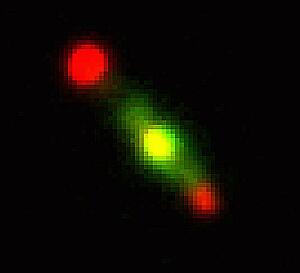 |
| Figure 2. The highly collimated PN K4–47. Green is [OIII], red is [NII]. [ JPEG | TIFF ] |
'Eccentricity' 2: Microstructures
Many PNe show enigmatic small-scale
structures, usually observed in the light of low-ionisation species such
as [NII] or [OI]. They are found in the form of knots, tails, ansae, filaments,
serpentines, jets, jet-like structures... (the nomenclature used in the literature
is intimidating) attached to or detached from the main bodies of the PNe.
The origin of many of these structures, such as the low-velocity but highly-collimated
structures observed in several PNe, is puzzling (cf. Goncalves
et al., 2001). Other ones can be associated to the development of dynamical
(Kelvin-Helmholtz and Rayleigh-Taylor) and radiative instabilities during
the PN evolution. Examples of two PNe containing this kind of low-ionisation
small-scale structures are given in Figure 3 (from Corradi
et al., 1999).
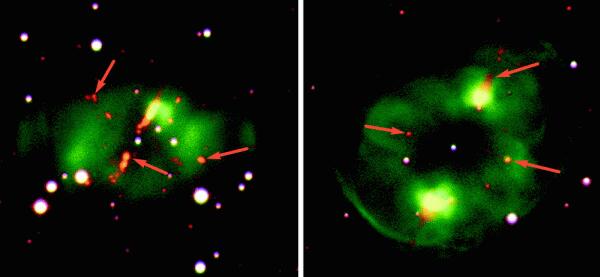 |
| Figure 3. The PNe K1–2 (left) and Wray 17–1 (right). Green is [OIII], red is [NII]. The low-ionisation microstructure discussed in the text are the red features indicated by red arrows. [ JPEG | TIFF ] |
'Eccentricity' 3: A Nebular Corkscrew
M 2–9 (Figure
4) is a special case in the already special class of bipolar PNe. Contrary
to most of bipolar PNe, it has a low temperature central star, unusually
low N and He chemical abundances, peculiar dusty jets which are seen only
as reflected light (Schwarz
et al., 1997), and a unique rotating emission pattern that we have
recently studied by collecting CCD images over a period of 15 yrs (Doyle
et al., 2000). These images show that the morphological changes resemble
a rotating corkscrew-like pattern, as if a precessing particle beam flowing
with a speed of several 1000 km/s (a 'spray') shock-heats and ionises
the walls of the main bipolar lobes of the nebula. The rotation period
of the pattern is about 120 yrs. A gif animation can be found at:
http://cdsaas.u-strasbg.fr:2001/AJ/journal/issues/v119n3/990457/990457.html
It seems unavoidable to invoke
the presence of an interacting stellar companion to produce such a rotating
spray of particles. This would also provide an easier way to collimate
the main bipolar outflow. No observational evidence for binarity, however,
has been found yet.
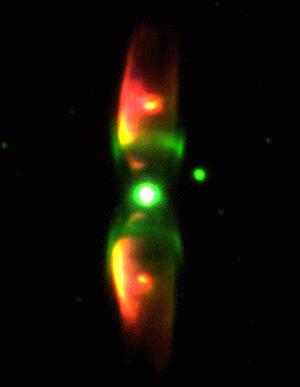 |
| Figure 4. The "Butterfly" Nebula M 2–9. Green is [OIII], red is [NII]. [ JPEG | TIFF ] |
'Eccentricity' 4: Stellar Symbiosis
The existence of a stellar companion
is certainly known for the case of the symbiotic Mira He 2–104, a brilliant
example of the kind of mass loss that one would expect during the late
AGB if a white dwarf companion is present at a moderate distance (some
10 AU). The nebula around He2–104, named the 'Southern Crab' for its characteristic
morphology, was discovered by Schwarz
et al. (1989). Recently, we have obtained HST images (Figure 5)
and ground-based echelle spectra to study its dynamics (Corradi
et al., 2001).
The nebula is composed of two nested pairs of lobes and symmetrical polar
jets. Surprisingly, the new data no longer support our previous idea that
the nested bipolar nebulae of He 2–104 are the result of two 'identical'
mass loss events from the white dwarf companion of the Mira, produced during
two similar nova-like outbursts separated by some thousand years. The echelle
spectra show in fact that the inner pair of lobes is expanding with velocities
one order of magnitude lower than the outer pair, and modelling shows
that the kinematical age of the two outflows is the same (and also coincides
with the age of the polar jets)! Thus all three different outflows from
He 2–104 are coeval, within the observational uncertainties, and were produced
about 5000 yrs ago. We present a new model in which enhanced mass
loss from the Mira, possibly following a thermal pulse, triggers
activity on the white dwarf companion, the formation of an accretion disc
and concomitant high velocity outflows forming the outer pair of lobes
and jets. The inner, slowly expanding lobes would instead be produced by
the enhanced Mira wind itself. For both pairs of lobes, the collimating
'nozzle' would be a circumbinary massive torus of gas produced by the Mira
wind during a previous, long period of more quiescent mass loss, and focussed
onto the orbital plane by the gravitational effects of the companion.
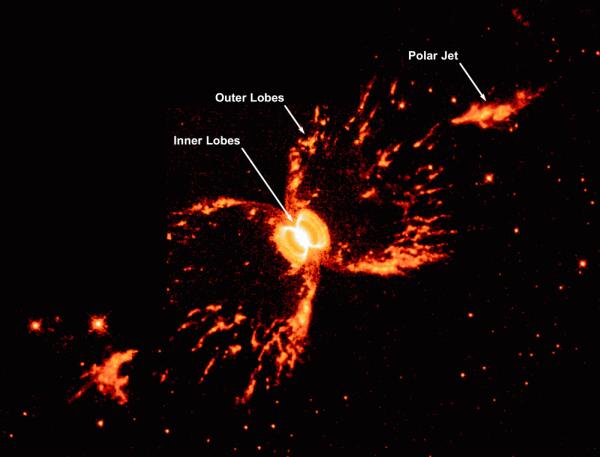 |
| Figure 5. HST [NII] image of the symbiotic nebula He 2–104, the "Southern Crab". [ JPEG | TIFF ] |
A conference on symbiotic stars is being organised by the ING and will be held on La Palma on May 2002. I expect that this will be the occasion to strengthen the belief that shaping mechanisms of the type discussed for He 2–104 may be operating in many PNe and related objects, such as novae, supernovae and young stars.
References:
Notes:
1:
The fraction of bipolar PNe is similar to the fraction of spherical ones.
What is then 'normal' and what 'eccentric'?
Email
contact: Romano Corradi (rcorradi@ing.iac.es)
| Previous: | Scientific Impact of Large Telescopes | Up: | Table of Contents | Next: | NAOMI – Adaptive Optics at the WHT |
| GENERAL | THE ING WIDE FIELD IMAGING SURVEY | SCIENCE | TELESCOPES AND INSTRUMENTATION | OTHER NEWS FROM ING | TELESCOPE TIME |